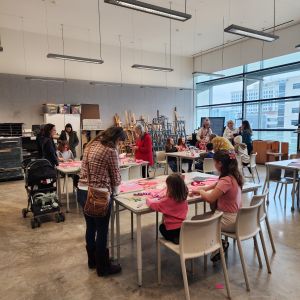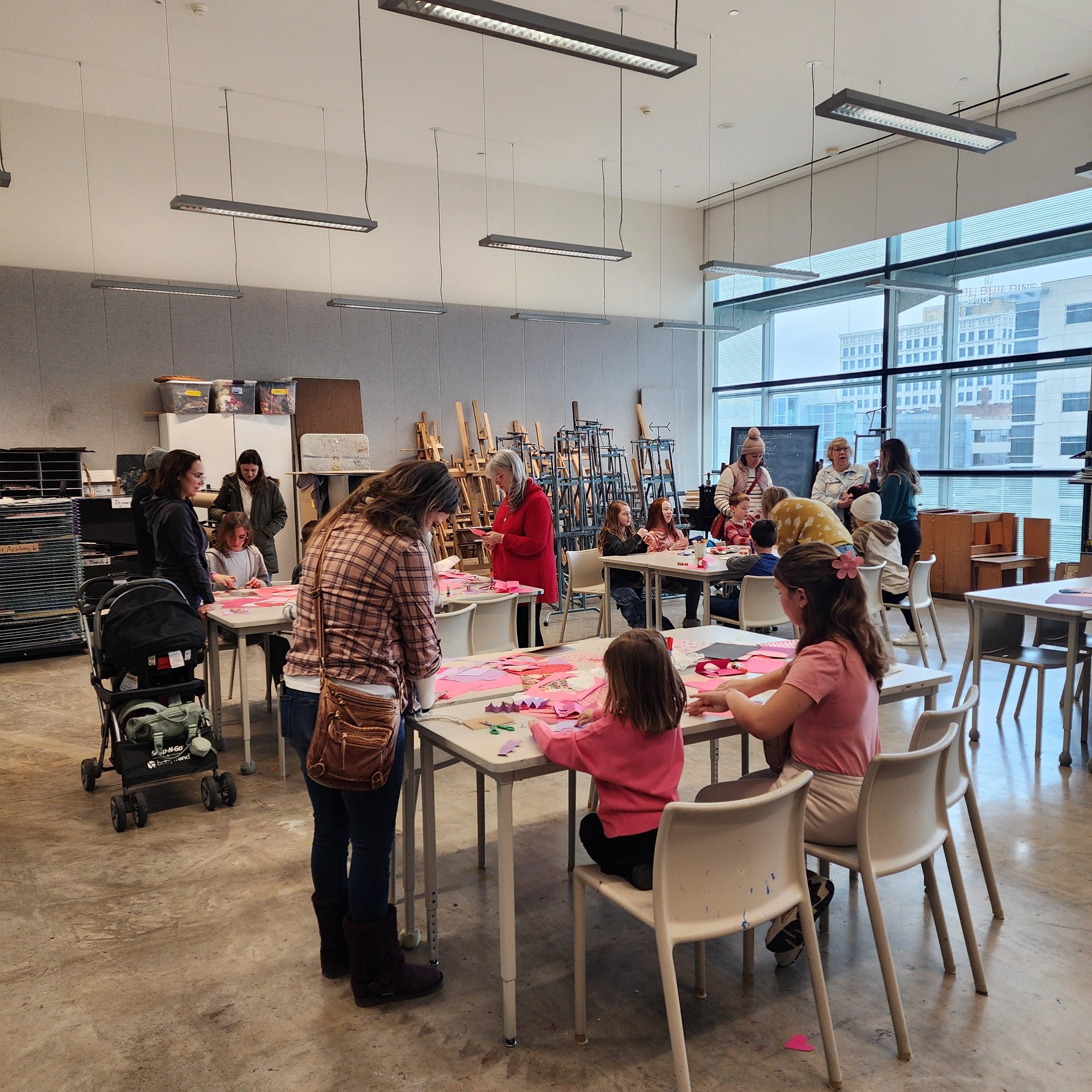

A New Chapter for Kaleidoscope: A Beloved Art Program Joins the Figge
For more than 40 years, Kaleidoscope has been a cornerstone of creative expression in the Quad Cities, inspiring thousands of young artists and their families. Now that the program has transitioned to the Figge Art Museum, its mission remains unchanged: to provide an accessible, exploratory, and joy-filled art experiences for children of all backgrounds.
We sat down with Rowen Schussheim-Anderson, longtime director of Kaleidoscope, to reflect on the program’s history, its impact on the community, and what families can look forward to as it embarks on this exciting new chapter.
The Origins of Kaleidoscope: A Vision for Accessible Art
Kaleidoscope’s roots trace back to Augustana College, where a small children’s art program had existed for decades before Rowen assumed leadership in 1982. Tasked with expanding it into a true community initiative, she partnered with Quad City Arts to develop an inclusive, non-sequential curriculum that welcomed children from ages 3 to 15.
Unlike traditional art classes focused on technical mastery, Kaleidoscope emphasized creative exploration. “It was all about process, not product,” Rowen shares. “We wanted to provide children with opportunities to experiment with materials, to express themselves, and to understand that there isn’t just one solution to a creative problem.”
For many students, Kaleidoscope was their first—and sometimes only—exposure to hands-on art education. In schools where formal art instruction was limited or nonexistent, the program filled a crucial gap. “So many Quad Cities schools don’t have dedicated art programs,” Rowen explains. “It really depended on how much an elementary school teacher chose to incorporate art into their classroom. We wanted to give kids that missing piece.”
Why Kaleidoscope Endures: The Power of Teachers and Families
Over the decades, Kaleidoscope’s success has been fueled by two essential ingredients: passionate teachers and dedicated families.
“Our teachers have always been local artists and educators,” Rowen notes. “Many of them come from public schools or the greater community, bringing fresh ideas and perspectives to each session. That’s what keeps Kaleidoscope dynamic—no two classes are ever the same.”
And then, of course, there are the families—the parents who bring their children on Saturday mornings or to summer art camps, the kids who eagerly return each session, and even the alumni who now enroll their own children in the program. “We have generations of families who have been part of Kaleidoscope,” she says. “Some of our earliest students are now bringing their grandchildren. That continuity speaks to how much this program means to the community.”
Art for Everyone: Why Affordability and Accessibility Matter
Since its inception, Kaleidoscope has maintained a steadfast commitment to affordability. “Art should never be exclusive or only for the elite,” Rowen asserts. "Art is a fundamental form of expression—something that every person, regardless of background, has the right and the need to engage in. It’s about finding your voice, discovering new ways to communicate, and making sense of the world around you. The goal was never to make money—it was to make sure every child had access to creative expression.”
This accessibility is more important than ever in today’s world, where extracurricular activities often come with a high price tag. “We’ve always worked to keep the cost low, using repurposed materials when we could. We live in a time where so many enrichment activities are expensive,” Rowen says. “We didn’t want cost to be a barrier for families. That’s something we’ll continue prioritizing as Kaleidoscope transitions to the Figge.”
The Magic of Creativity: Kaleidoscope’s Lasting Impact
Beyond teaching children how to mix colors or shape clay, Kaleidoscope instills something deeper: a lifelong appreciation for art.
One of the more memorable examples of Kaleidoscope’s impact is the story of Seth Chappell, a former student who has come full circle as an instructor. As a child, Seth took one of Kaleidoscope's earliest puppetry classes and fell in love with the art form. The experience left such a lasting impact that he pursued a career in puppetry and the performing arts. Today, Seth is not only a professional puppeteer but also a dedicated educator who now teaches at Kaleidoscope.
“We looked it up, and Seth was in one of our very first classes,” Rowen recalls. “Now, he’s back, teaching a new generation of kids and sharing the same creative spark that first inspired him years ago. It’s incredibly rewarding to see how Kaleidoscope has shaped lives in such profound ways.” Seth’s story is a perfect example of how early creative experiences can ignite a lifelong passion, leading students to careers that continue to enrich the community.
But for every student who becomes a professional artist, there are countless others whose lives are simply enriched by the experience. “We hear from former students all the time who tell us that Kaleidoscope made them feel confident, curious, and inspired,” Rowen says. “Even if they never pick up a paintbrush again, they carry that sense of wonder with them.”
What’s Next: Kaleidoscope at the Figge Art Museum
Now housed at the Figge Art Museum, Kaleidoscope is poised to offer even more enriching experiences for young artists.
“What’s exciting about being at the Figge is that we can integrate museum resources into the program,” Rowen says. “Children will have the opportunity to explore exhibitions, sketch in the galleries, and draw inspiration from real works of art.”
While the program will remain true to its roots, families can also look forward to expanded offerings in the future. This summer, Kaleidoscope will welcome children ages 5–12 for themed art camps and workshops, with plans to broaden age ranges in the fall.
Why Enroll? What Parents Should Know
For parents on the fence about signing their child up for a Kaleidoscope class, Rowen has one piece of advice: go for it.
“Kids have a wonderful time here,” she says. “They get to step away from screens, use their hands, and explore new materials in a supportive environment. Our teachers are some of the best in the area, and we’re committed to keeping the program affordable. It’s a space where kids can create, imagine, and just be themselves.”





